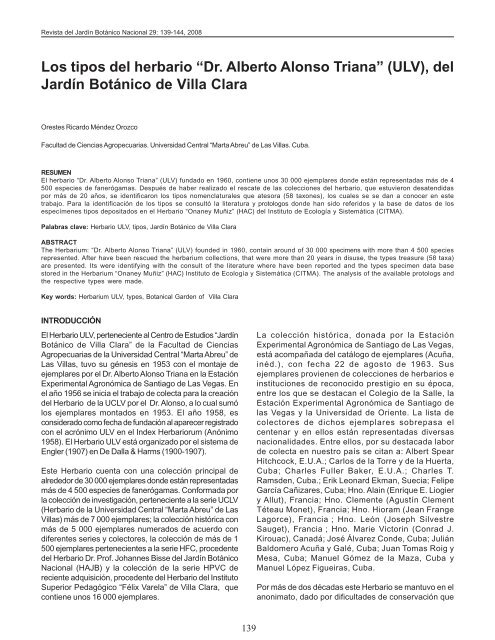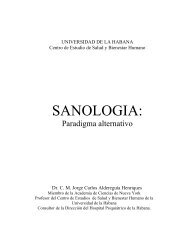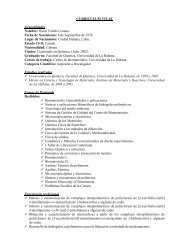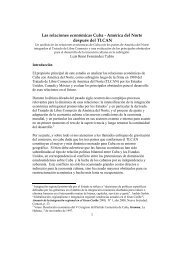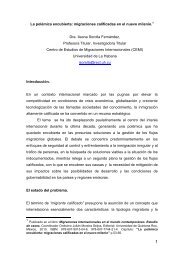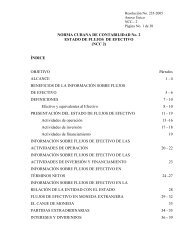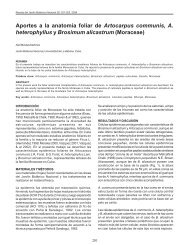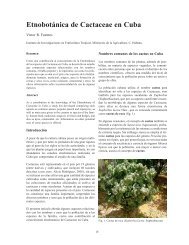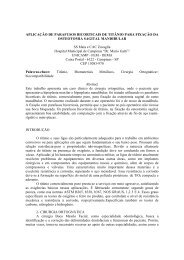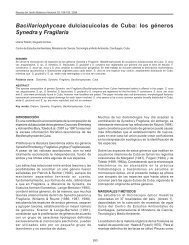descargar / download - Universidad de La Habana
descargar / download - Universidad de La Habana
descargar / download - Universidad de La Habana
You also want an ePaper? Increase the reach of your titles
YUMPU automatically turns print PDFs into web optimized ePapers that Google loves.
Revista <strong>de</strong>l Jardín Botánico Nacional 29: 139-144, 2008<br />
Los tipos <strong>de</strong>l herbario “Dr. Alberto Alonso Triana” (ULV), <strong>de</strong>l<br />
Jardín Botánico <strong>de</strong> Villa Clara<br />
Orestes Ricardo Mén<strong>de</strong>z Orozco<br />
Facultad <strong>de</strong> Ciencias Agropecuarias. <strong>Universidad</strong> Central “Marta Abreu” <strong>de</strong> <strong>La</strong>s Villas. Cuba.<br />
RESUMEN<br />
El herbario “Dr. Alberto Alonso Triana” (ULV) fundado en 1960, contiene unos 30 000 ejemplares don<strong>de</strong> están representadas más <strong>de</strong> 4<br />
500 especies <strong>de</strong> fanerógamas. Después <strong>de</strong> haber realizado el rescate <strong>de</strong> las colecciones <strong>de</strong>l herbario, que estuvieron <strong>de</strong>satendidas<br />
por más <strong>de</strong> 20 años, se i<strong>de</strong>ntificaron los tipos nomenclaturales que atesora (58 taxones), los cuales se se dan a conocer en este<br />
trabajo. Para la i<strong>de</strong>ntificación <strong>de</strong> los tipos se consultó la literatura y protologos don<strong>de</strong> han sido referidos y la base <strong>de</strong> datos <strong>de</strong> los<br />
especímenes tipos <strong>de</strong>positados en el Herbario “Onaney Muñiz” (HAC) <strong>de</strong>l Instituto <strong>de</strong> Ecología y Sistemática (CITMA).<br />
Palabras clave: Herbario ULV, tipos, Jardín Botánico <strong>de</strong> Villa Clara<br />
ABSTRACT<br />
The Herbarium: “Dr. Alberto Alonso Triana” (ULV) foun<strong>de</strong>d in 1960, contain around of 30 000 specimens with more than 4 500 species<br />
represented. After have been rescued the herbarium collections, that were more than 20 years in disuse, the types treasure (58 taxa)<br />
are presented. Its were i<strong>de</strong>ntifying with the consult of the literature where have been reported and the types specimen data base<br />
stored in the Herbarium “Onaney Muñiz” (HAC) Instituto <strong>de</strong> Ecología y Sistemática (CITMA). The analysis of the available protologs and<br />
the respective types were ma<strong>de</strong>.<br />
Key words: Herbarium ULV, types, Botanical Gar<strong>de</strong>n of Villa Clara<br />
INTRODUCCIÓN<br />
El Herbario ULV, perteneciente al Centro <strong>de</strong> Estudios “Jardín<br />
Botánico <strong>de</strong> Villa Clara” <strong>de</strong> la Facultad <strong>de</strong> Ciencias<br />
Agropecuarias <strong>de</strong> la <strong>Universidad</strong> Central “Marta Abreu” <strong>de</strong><br />
<strong>La</strong>s Villas, tuvo su génesis en 1953 con el montaje <strong>de</strong><br />
ejemplares por el Dr. Alberto Alonso Triana en la Estación<br />
Experimental Agronómica <strong>de</strong> Santiago <strong>de</strong> <strong>La</strong>s Vegas. En<br />
el año 1956 se inicia el trabajo <strong>de</strong> colecta para la creación<br />
<strong>de</strong>l Herbario <strong>de</strong> la UCLV por el Dr. Alonso, a lo cual sumó<br />
los ejemplares montados en 1953. El año 1958, es<br />
consi<strong>de</strong>rado como fecha <strong>de</strong> fundación al aparecer registrado<br />
con el acrónimo ULV en el In<strong>de</strong>x Herbariorum (Anónimo<br />
1958). El Herbario ULV está organizado por el sistema <strong>de</strong><br />
Engler (1907) en De Dalla & Harms (1900-1907).<br />
Este Herbario cuenta con una colección principal <strong>de</strong><br />
alre<strong>de</strong>dor <strong>de</strong> 30 000 ejemplares don<strong>de</strong> están representadas<br />
más <strong>de</strong> 4 500 especies <strong>de</strong> fanerógamas. Conformada por<br />
la colección <strong>de</strong> investigación, perteneciente a la serie UCLV<br />
(Herbario <strong>de</strong> la <strong>Universidad</strong> Central “Marta Abreu” <strong>de</strong> <strong>La</strong>s<br />
Villas) más <strong>de</strong> 7 000 ejemplares; la colección histórica con<br />
más <strong>de</strong> 5 000 ejemplares numerados <strong>de</strong> acuerdo con<br />
diferentes series y colectores, la colección <strong>de</strong> más <strong>de</strong> 1<br />
500 ejemplares pertenecientes a la serie HFC, proce<strong>de</strong>nte<br />
<strong>de</strong>l Herbario Dr. Prof. Johannes Bisse <strong>de</strong>l Jardín Botánico<br />
Nacional (HAJB) y la colección <strong>de</strong> la serie HPVC <strong>de</strong><br />
reciente adquisición, proce<strong>de</strong>nte <strong>de</strong>l Herbario <strong>de</strong>l Instituto<br />
Superior Pedagógico “Félix Varela” <strong>de</strong> Villa Clara, que<br />
contiene unos 16 000 ejemplares.<br />
139<br />
<strong>La</strong> colección histórica, donada por la Estación<br />
Experimental Agronómica <strong>de</strong> Santiago <strong>de</strong> <strong>La</strong>s Vegas,<br />
está acompañada <strong>de</strong>l catálogo <strong>de</strong> ejemplares (Acuña,<br />
inéd.), con fecha 22 <strong>de</strong> agosto <strong>de</strong> 1963. Sus<br />
ejemplares provienen <strong>de</strong> colecciones <strong>de</strong> herbarios e<br />
instituciones <strong>de</strong> reconocido prestigio en su época,<br />
entre los que se <strong>de</strong>stacan el Colegio <strong>de</strong> la Salle, la<br />
Estación Experimental Agronómica <strong>de</strong> Santiago <strong>de</strong><br />
las Vegas y la <strong>Universidad</strong> <strong>de</strong> Oriente. <strong>La</strong> lista <strong>de</strong><br />
colectores <strong>de</strong> dichos ejemplares sobrepasa el<br />
centenar y en ellos están representadas diversas<br />
nacionalida<strong>de</strong>s. Entre ellos, por su <strong>de</strong>stacada labor<br />
<strong>de</strong> colecta en nuestro país se citan a: Albert Spear<br />
Hitchcock, E.U.A.; Carlos <strong>de</strong> la Torre y <strong>de</strong> la Huerta,<br />
Cuba; Charles Fuller Baker, E.U.A.; Charles T.<br />
Rams<strong>de</strong>n, Cuba.; Erik Leonard Ekman, Suecia; Felipe<br />
García Cañizares, Cuba; Hno. Alain (Enrique E. Liogier<br />
y Allut), Francia; Hno. Clemente (Agustín Clement<br />
Téteau Monet), Francia; Hno. Hioram (Jean Frange<br />
<strong>La</strong>gorce), Francia ; Hno. León (Joseph Silvestre<br />
Sauget), Francia ; Hno. Marie Victorin (Conrad J.<br />
Kirouac), Canadá; José Álvarez Con<strong>de</strong>, Cuba; Julián<br />
Baldomero Acuña y Galé, Cuba; Juan Tomas Roig y<br />
Mesa, Cuba; Manuel Gómez <strong>de</strong> la Maza, Cuba y<br />
Manuel López Figueiras, Cuba.<br />
Por más <strong>de</strong> dos décadas este Herbario se mantuvo en el<br />
anonimato, dado por dificulta<strong>de</strong>s <strong>de</strong> conservación que
se presentaron con todas las colecciones <strong>de</strong>l Jardín<br />
Botánico <strong>de</strong> Villa Clara, lo que provocó la duda entre<br />
especialistas nacionales y extranjeros sobre si aún<br />
existían las colecciones históricas <strong>de</strong>l Herbario y cuáles<br />
eran los valores que conservaban.<br />
Después <strong>de</strong> realizar una revisión minuciosa <strong>de</strong> las<br />
colecciones <strong>de</strong>l Herbario ULV, la literatura <strong>de</strong> referencia,<br />
la indagación en otros Herbarios que poseen duplicados<br />
<strong>de</strong> estas colecciones y con especialistas versados en la<br />
materia, se observó la existencia <strong>de</strong> numerosos tipos<br />
nomenclaturales que estimuló la conformación <strong>de</strong>l<br />
presente trabajo que tiene como objetivo dar a conocer<br />
los tipos nomenclaturales presentes en el Herbario ULV<br />
para poner a disposición <strong>de</strong> especialistas nacionales y<br />
extranjeros esta valiosa información para su uso en<br />
estudios taxonómicos u otros que lo requieran.<br />
MATERIALES Y MÉTODOS<br />
Se revisó toda la colección <strong>de</strong>l Herbario y su libro <strong>de</strong><br />
registro, separándose los ejemplares pertenecientes a las<br />
series UCLV y HFC, <strong>de</strong> los ejemplares históricos; estos<br />
últimos fueron confrontados con el catálogo <strong>de</strong> plantas <strong>de</strong><br />
dicha colección (Acuña, inéd.). <strong>La</strong> i<strong>de</strong>ntificación <strong>de</strong> tipos<br />
se realizó con la consulta <strong>de</strong> la literatura especializada<br />
(Cár<strong>de</strong>nas & Herrera, 1991, Gutiérrez & al. 1998); así como<br />
la base <strong>de</strong> datos <strong>de</strong> los tipos <strong>de</strong>l HAC (Ventosa & al.<br />
inéd.). Se realizó el análisis <strong>de</strong> los protólogos disponibles<br />
y los tipos correspondientes.<br />
RESULTADOS<br />
Como resultado <strong>de</strong>l pesquizaje realizado, se encontró que<br />
inicialmente estaban <strong>de</strong>positados en este herbario 70<br />
especímenes tipos don<strong>de</strong> estaban representadas 60<br />
taxones, <strong>de</strong> los cuales se perdieron las exsiccata tipos<br />
que representaban a Cynometra ophiticola Borhidi (J. Acuña,<br />
Correll y J. T. Roig 18476) y Vitex guanahacabibensis<br />
Borhidi (J. Acuña y F. Zayas 19938) pertenecientes a la<br />
colección histórica. Quedando en la actualidad 68<br />
exsiccatas tipo que representan a 58 taxones.<br />
Se relaciona el nombre científico <strong>de</strong> cada tipo, or<strong>de</strong>nados<br />
alfabéticamente por familia, género y especie. <strong>La</strong> citación<br />
<strong>de</strong> los autores fue realizada siguiendo el criterio <strong>de</strong> Brummit<br />
& Powell (1992). Se cita la publicación <strong>de</strong>l protólogo, los<br />
datos presentes en la etiqueta <strong>de</strong> referencia en nuestro<br />
Herbario y la cantidad <strong>de</strong> exsiccatas <strong>de</strong> cada taxón.<br />
Acanthaceae<br />
Barleriola saturejoi<strong>de</strong>s (Griseb.) M. Gómez subsp. acunae<br />
Borhidi & O. Muñiz<br />
Acta Bot. Acad. Sci. Hung. 17 (1-2): 28. 1972.<br />
Isotipo<br />
5193 J. Acuña<br />
Oriente. Baracoa, Camino <strong>de</strong> Montecristo a Jauco.<br />
Febrero, 1929<br />
Mén<strong>de</strong>z Orozco, O. R.: Los tipos nomenclaturales <strong>de</strong>l herbario “Dr. Alberto Alonso Triana”<br />
140<br />
Elytraria planifolia Leonard subsp. acunae Borhidi<br />
Acta Bot. Acad. Sci. Hung. 23 (3-4): 315. 1978.<br />
Isotipo<br />
16322 J. Acuña y E. Rodríguez<br />
Camagüey. Camino <strong>de</strong> Cubitas, sabanas serpentinosas.<br />
Agosto 1, 1950<br />
<strong>La</strong>chnorhiza piloselloi<strong>de</strong>s A. Rich. subsp. stenophylla<br />
Borhidi<br />
Acta Bot. Acad. Sci. Hung. 29 (1-4): 213. 1983.<br />
Isotipo<br />
15307 Mr. & Mrs Mol<strong>de</strong>nke, Hno. León, Hno. Alain y<br />
J. Acuña<br />
Pinar <strong>de</strong>l Río. San Luis, Pinares próximos a laguna<br />
Santa Maria.<br />
Noviembre 29, 1948.<br />
Oplonia acunae Borhidi<br />
Acta Bot. Acad. Sci. Hung. 23 (3-4): 313. 1978.<br />
Isotipo<br />
9710 J. Acuña<br />
Oriente. Pico Turquino, Pico Cuba.<br />
Agosto 1-2, 1935<br />
Annonaceae<br />
Xylopia cristalensis Alain<br />
Candollea 17: 108. 1960.<br />
Isotipo<br />
5435 Hno. Alain, J. Acuña y M. López Figueiras<br />
Oriente. Cristal, charrascos <strong>de</strong> Saca Lengua.<br />
Abril 2-7, 1956<br />
Apocynaceae<br />
Neobracea martiana Borhidi & O. Muñiz<br />
Acta Bot. Acad. Sci. Hung. 17 (1-2): 22. 1971.<br />
Isotipo<br />
39 M. López Figueiras<br />
Oriente. Siboney, camino <strong>de</strong> Sardinero, mirando al mar,<br />
sobre farallones.<br />
Agosto 26, 1951<br />
Aquifoliaceae<br />
Ilex eoa Alain<br />
Candollea 17: 117. 1960.<br />
Isotipo<br />
5426 Hno. Alain, J. Acuña y M. López Figueiras<br />
Oriente. Mayarí. Cristal, charrascos <strong>de</strong> Saca Lengua,<br />
suelos lateríticos-serpentinosos.<br />
Abril 2-7, 1956<br />
Ilex subavenia Alain<br />
Phytologia 8: 369. 1962.<br />
Isotipo<br />
5644 Hno. Alain, J. Acuña y M. López Figueiras<br />
Oriente. Mayarí, charrascos <strong>de</strong>l Cristal.<br />
Abril 2-7, 1956
Revista <strong>de</strong>l Jardín Botánico Nacional 29: 139-144, 2008<br />
Arecaceae<br />
Calyptronoma clementis (León) A. D. Hawkes subsp.<br />
orientensis O. Muñíz & Borhidi<br />
Acta Bot. Acad. Sci. Hung. 28 (3- 4): 342. 1982.<br />
Isotipo<br />
13019 J. Acuña<br />
Oriente. Baracoa, Moa, Monte Centeno.<br />
Noviembre 12, 1945<br />
Bignoniaceae<br />
Tabebuia turquinensis Alain<br />
Contrib. Ocas. Mus. Hist. Nat. Colegio “De la Salle”, 15:<br />
19. 1956.<br />
Isotipo<br />
10216 J. Acuña<br />
Oriente, falda Sur <strong>de</strong>l Pico Turquino.<br />
Junio 10, 1936<br />
Boraginaceae<br />
Cordia van-hermanii Alain<br />
Contrib. Ocas. Mus. Hist. Nat. Colegio “De la Salle”, 15: 11 1956.<br />
Isotipo<br />
14120 H. A. van Hermann<br />
Oriente. Mayarí, Lengua <strong>de</strong> Pájaro.<br />
Marzo, 1943<br />
Buxaceae<br />
Buxus acunae Borhidi & O. Muñiz<br />
Acta Bot. Hung. 22: 307. 1976.<br />
Isotipo<br />
13168 J. Acuña<br />
Oriente. Baracoa. Moa, breñales <strong>de</strong> Playa <strong>La</strong> Vaca.<br />
Noviembre 9, 1945<br />
Campanulaceae<br />
Lobelia cubana Urb.<br />
Symb. Antill. 1: 455. 1900.<br />
Topótipo<br />
14635 J. Acuña y J. T. Roig<br />
Pinar <strong>de</strong>l Río. Pan <strong>de</strong> Guajaibón, paredones calizos.<br />
Diciembre 30, 1936<br />
Celastraceae<br />
Maytenus buxifolia (A. Rich.) Griseb. subsp. cajalbanica<br />
Borhidi & O. Muñiz<br />
Acta Bot. Hung. 17: 14. 1971.<br />
Isotipo<br />
24945 J. Acuña y Hno. Alain<br />
Pinar <strong>de</strong>l Río. <strong>La</strong> Cajálbana. <strong>La</strong> Palma.<br />
Diciembre 3, 1949<br />
Torralbasia cuneifolia (Wr.) Krug. & Urb. var. rotundata<br />
Borhidi<br />
Acta Agron. Acad. Sci. Hung. 27: 434. 1978.<br />
Isotipo<br />
2210 M. López Figueiras<br />
141<br />
Oriente. Baracoa. Taco Bay, Sierra Iberia, entre la base y<br />
Río Iberia.<br />
Julio 25, 1960<br />
Combretaceae<br />
Terminalia pachystyla Borhidi<br />
Acta Bot. Hung. 21: 224. 1975.<br />
Isotipo<br />
5368 Hno. Alain, J. Acuña y M. López Figueiras<br />
Oriente. Mayarí. Nicaro, subida <strong>de</strong> Los Mulos.<br />
Abril 2-7, 1956<br />
Fabaceae<br />
Ateleia bissei A. Barreto<br />
Fontqueria 44: 250.1996.<br />
Isotipo (2)<br />
36076 J. Bisse et al.<br />
Holguín. Mogotes <strong>de</strong> caliza, cerca <strong>de</strong>l terraplén <strong>de</strong> Miranda<br />
a los Pinares <strong>de</strong> Mayarí.<br />
Noviembre 3, 1977<br />
Behaimia roigii Borhidi<br />
Acta Agron. Acad. Sci. Hung. 27: 430. 1978.<br />
Isotipo<br />
7482 J. T. Roig<br />
<strong>La</strong>s Villas. Zapata, Caleta el Rosario.<br />
Agosto 3, 1920<br />
Harpalyce alainii León<br />
Contrib. Ocas. Mus. Hist. Nat. Colegio “De la Salle” 9: 14. 1950.<br />
Isotipo<br />
12439 J. Acuña<br />
Oriente. Baracoa. Moa. Cayo Coco, suelos ferruginosos.<br />
Abril 15, 1945<br />
Harpalyce cristalensis Borhidi & O. Muñiz<br />
Ciencias Biol. Acad. Ci. Cuba (<strong>La</strong> <strong>Habana</strong>) 1: 133-134.1977.<br />
Isotipo<br />
19671 J. Acuña y F. Zayas<br />
Oriente. Cristal. Sierra Saca la Lengua.<br />
Mayo 26-27, 1955<br />
Harpalyce cubensis var. cajalbanensis Borhidi & O. Muñiz<br />
Ciencias Biol. Acad. Ci. Cuba (<strong>La</strong> <strong>Habana</strong>) 1: 136. 1977.<br />
Isotipo<br />
16601 J. Acuña y J. T. Roig<br />
Pinar <strong>de</strong>l Río. Pelada <strong>de</strong> <strong>La</strong> Cajálbana.<br />
Febrero 2, 1951<br />
Flacourtiaceae<br />
Banara wilsoni Alain<br />
Contrib. Ocas. Mus. Hist. Nat. Colegio “De la Salle”, 12: 7. 1953.<br />
Isotipo<br />
5808 M. Curbelo<br />
Oriente. Puerto Padre, terrenos bajos.<br />
Septiembre 1, 1931
<strong>La</strong>miaceae<br />
Satureja suborbicularis Alain<br />
Contrib. Ocas. Mus. Hist. Nat. Colegio “De la Salle”,<br />
15: 13. 1956.<br />
Isotipo<br />
5242 Hno. Alain<br />
Oriente. Baracoa, farallones <strong>de</strong> Jauco.<br />
Enero 16, 1956<br />
Lythraceae<br />
Ginoria thomasiana Alain<br />
Revista Soc. Cub. Bot. X: 30. 1953.<br />
Isotipo<br />
16182 J. Acuna, Hno. Alain, Hno. León & O. Muñiz<br />
Pinar <strong>de</strong>l Río. <strong>La</strong> Palma, <strong>La</strong> Cajálbana.<br />
Junio 10, 1950<br />
Malpighiaceae<br />
Malpighia nummulariaefolia subsp. cristalensis F.<br />
K. Mey.<br />
Revista Jard. Bot. Nac. Univ. <strong>Habana</strong> 3(2): 30-31. 1982.<br />
Isotipo<br />
19679 J. Acuña y F. Zayas<br />
Oriente. Cristal. Sierra Saca la Lengua.<br />
Mayo 26-27, 1955<br />
Melastomataceae<br />
Calycogonium revolutum Alain.<br />
Contrib. Ocas. Mus. Hist. Nat. Colegio “De la Salle”, 14: 7. 1955.<br />
Isotipo (2)<br />
13286 J. Acuña<br />
Oriente. Baracoa. Moa, montes <strong>de</strong> Cayo Chico.<br />
Noviembre 13. 1945<br />
Cli<strong>de</strong>mia lopezii Alain<br />
Contrib. Ocas. Mus. Hist. Nat. Colegio “De la Salle”,<br />
15: 6-7. 1956.<br />
Isotipo<br />
2285 M. López Figueiras<br />
Oriente. Sierra Maestra. En el Pinalón, alto <strong>de</strong> la<br />
Valenzuela.<br />
Agosto 11, 1955<br />
Henriettella acunai Alain<br />
Contrib. Ocas. Mus. Hist. Nat. Colegio “De la Salle”,<br />
14: 9. 1955.<br />
Isotipo (2)<br />
13278 J. Acuña<br />
Oriente. Baracoa. Moa, montes <strong>de</strong> <strong>La</strong> Breña, suelos<br />
ferruginosos.<br />
Noviembre 5, 1945<br />
Ossaea acunae Alain<br />
Contrib. Ocas. Mus. Hist. Nat. Colegio “De la Salle”,<br />
15: 7. 1956.<br />
Isotipo<br />
Mén<strong>de</strong>z Orozco, O. R.: Los tipos nomenclaturales <strong>de</strong>l herbario “Dr. Alberto Alonso Triana”<br />
142<br />
19752 J. Acuña y F. Zayas<br />
Oriente. Mayarí. Nicaro, Sierra <strong>de</strong> la Escalera, suelos<br />
ferruginosos.<br />
Mayo 26-27, 1955<br />
Tetrazygia acunae Borhidi<br />
Acta Bot. Acad. Sci. Hung. 23 (1-2): 38. 1977.<br />
Isotipo<br />
19452 J. Acuña<br />
Oriente. Sierra Maestra, Proximida<strong>de</strong>s <strong>de</strong>l Pico Turquino.<br />
Julio, 1936<br />
Tetrazygia bicolor (Mill.) Cogn. var. patenti-setosa Borhidi<br />
Acta Bot. Hung. 23: 39.1977.<br />
Isotipo.<br />
19461 J. Acuña y Torres<br />
Pinar <strong>de</strong>l Río. Cerro <strong>de</strong> Cabras, maniguas a la subida.<br />
Octubre 10, 1954<br />
Mimosaceae<br />
Pithecellobium asplenifolium subsp. mayarense Borhidi<br />
Acta Bot. Hung. 22: 298. 1976.<br />
Isotipo<br />
19663 J. Acuña y F. Zayas<br />
Oriente. Mayarí. Nicaro, montes <strong>de</strong> la United Fruit.<br />
Mayo 26-27, 1955<br />
Myrtaceae<br />
Calyptranthes albicans Borhidi<br />
Bot. Közlem. 64 (1): 14. 1977.<br />
Isotipo<br />
18802 J. Acuña, Alonso y Pino<br />
Oriente. Mayarí. Minas <strong>de</strong> Nicaro, Ocujal.<br />
Julio, 1953<br />
Calyptranthes cristalensis Borhidi<br />
Bot. Közlem. 64 (1): 16. 1977.<br />
Isotipo<br />
5433 Hno. Alain, J. Acuña y M. López Figueiras<br />
Oriente. Mayarí, charrascos <strong>de</strong> Saca la Lengua.<br />
Abril 2-7, 1956<br />
Myrcia acunae Borhidi<br />
Bot. Kozlem. 64 (1): 20. 1977.<br />
Isotipo<br />
13250 J. Acuña<br />
Oriente, Baracoa, Moa, Cayo Chico.<br />
Noviembre 13, 1945<br />
Myrcia spinifolia Borhidi & Acuña<br />
Bot. Kozlem 64(3):215. 1977.<br />
Isotipo<br />
5855 Hno. Alain, J. Acuña y M. López Figueiras<br />
Oriente. Sierra Cristal, bosques <strong>de</strong> charrasco junto<br />
al rio Miguel.<br />
Abril 2-7, 1956
Revista <strong>de</strong>l Jardín Botánico Nacional 29: 139-144, 2008<br />
Myrtus acunae Borhidi & O. Muñiz<br />
Acta Bot. Hung. 21: 230. 1975.<br />
Isotipo<br />
19735, 19736 J. Acuña y F. Zayas<br />
Oriente. Mayarí. Cristal. Loma Escalera.<br />
Mayo 26-27, 1955<br />
Plinia baracoensis Borhidi<br />
Bot. Kozlem 64(1): 19. 1977.<br />
Isotipo<br />
7617 Hno. Alain, J. Acuña y Ramos<br />
Oriente. Pinares y Cañadas al Norte <strong>de</strong>l Yunque<br />
<strong>de</strong> Baracoa.<br />
Enero 13, 1960.<br />
Plinia jackucsianum Borhidi<br />
Bot. Kozlem 64(3): 214. 1977.<br />
Isotipo<br />
7568 Hno. Alain y J. Acuña<br />
Oriente. Este <strong>de</strong>l Yunque <strong>de</strong> Baracoa, Charrasco <strong>de</strong> <strong>La</strong> Ermita.<br />
Enero 15, 1960<br />
Nyctaginaceae<br />
Guapira ophiticola Borhidi<br />
Acta Bot. Hung. 25: 4. 1979.<br />
Isotipo<br />
5436 Hno. Alain, J. Acuña & M. López Figueiras<br />
Oriente. Cristal. Subida <strong>de</strong> la Sierra Saca la Lengua.<br />
Abril 2-7, 1956<br />
Guapira peninsularis M. A. Díaz<br />
Revista Jard. Bot. Nac. Univ. <strong>Habana</strong> 2 (3): 6. 1981.<br />
Isotipo<br />
34544 A. Areces, J. Bisse, M. Díaz, H. Dietrich & L. Lepper<br />
Matanzas. Península <strong>de</strong> Zapata, montes a 5 km. al este<br />
<strong>de</strong> Playa Girón.<br />
Abril 20, 1977<br />
Passifloraceae<br />
Passiflora cubensis subsp. holguinensis Duharte<br />
Fed<strong>de</strong>s Repert. 96: 537. 1985.<br />
Isotipo<br />
13215 J. Acuña<br />
Oriente. Baracoa. Moa, junto a las casas.<br />
Noviembre 16, 1945.<br />
Polygonaceae<br />
Coccoloba acunae Howard<br />
J. Arnold Arbor. 30: 403. 1949.<br />
Isotipo (2)<br />
13094 J. Acuña<br />
Oriente. Baracoa. Moa, Breñales <strong>de</strong> Playa <strong>La</strong> Vaca.<br />
Noviembre 4, 1945<br />
143<br />
Rubiaceae<br />
Antirhea ophiticola Alain<br />
Contrib. Ocas. Mus. Hist. Nat. Colegio “De la Salle”,<br />
17: 1. 1959.<br />
Paratipo<br />
5423 Hno. Alain, J. Acuña y M. López Figueiras<br />
Oriente. Cristal, charrascos subida Saca la Lengua.<br />
Abril 2-7, 1956<br />
Antirhea ophiticola Alain<br />
Contr. Ocas. Mus. Hist. Nat. Colegio “De la Salle”, 17:<br />
1. 1959.<br />
Isotipo (2)<br />
19806 J. Acuña y F. Zayas<br />
Oriente. Mayarí. Sierra Cristal, Sierra Saca la Lengua.<br />
Mayo 26-27, 1955<br />
Exostema valenzuelana subsp. maestrense Borhidi & M.<br />
Fernán<strong>de</strong>z Zeq.<br />
Acta Bot. Hung. 35 (1-4): 305. 1989.<br />
Isotipo (2)<br />
10218 J. Acuña<br />
Oriente. Sierra Maestra, Sur <strong>de</strong>l Pico Turquino, Bor<strong>de</strong>s<br />
<strong>de</strong>l Río Portillo, tierras ácidas <strong>de</strong> montaña.<br />
Junio 10-26, 1936<br />
Phialanthus linearis Alain<br />
Contrib. Ocas. Mus. Hist. Nat. Colegio “De la Salle”, 17: 7. 1959.<br />
Isotipo<br />
13369 J. Acuña<br />
Oriente. Moa, cuabales <strong>de</strong> Playa <strong>La</strong> Vaca.<br />
Noviembre 3-18, 1945.<br />
Phialanthus marianus Borhidi<br />
Acta Bot. Hung. 29: 196.1983.<br />
Isotipo (3)<br />
36587 J. Bisse, L. González, G. Stohr & M. A. Díaz<br />
Guantánamo. San Antonio <strong>de</strong>l Sur. Abra <strong>de</strong> Mariana, loma<br />
al oeste <strong>de</strong>l barranco.<br />
Febrero 6, 1972<br />
Psychotria moralesii Acuña & Roig<br />
Brittonia 14: 224. 1962.<br />
Isotipo<br />
13360 J. Acuña<br />
Oriente. Baracoa. Moa. Monte Centeno, terrenos<br />
ferruginosos.<br />
Noviembre 3-18, 1945<br />
Randia cubana Borhidi<br />
Acta Bot. Hung. 27: 26. 1981.<br />
Isotipo<br />
32681 A. Areces, A. Alvarez, J. Bisse & E. Köhler<br />
Pinar <strong>de</strong>l Río. Bahía Honda. <strong>La</strong>s Pozas, cuabales al<br />
suroeste <strong>de</strong> <strong>La</strong>s Pozas.<br />
Octubre 16, 1976
Ron<strong>de</strong>letia linearisepala Alain<br />
Contrib. Ocas. Mus. Hist. Nat. Colegio “De la Salle”.<br />
<strong>Habana</strong> No. 18: 2. 1960.<br />
Isotipo<br />
7679 Hno. Alain<br />
Oriente. Baracoa, Farallones cerca Abra <strong>de</strong>l Yumurí.<br />
Enero16, 1960<br />
Stenostomum baracoense Borhidi<br />
Acta Bot. Hung. 38: 144. 1994.<br />
Isotipo (2)<br />
36878 J. Bisse et al.<br />
Guantánamo. Baracoa. Quibiján, pluviosilva <strong>de</strong> la zona <strong>de</strong><br />
Arroyo Blanco en el camino. Vega <strong>de</strong> la Palma.<br />
Febrero 16, 1978<br />
Rutaceae<br />
Ravenia baracoensis Borhidi<br />
Acta Bot. Hung. 22: 304-305. 1976.<br />
Isotipo<br />
7573 Hno. Alain y J. Acuña<br />
Oriente. Baracoa. Charrascos <strong>de</strong> la Ermita, este<br />
<strong>de</strong>l Yunque.<br />
Enero 12, 1960<br />
Sapindaceae<br />
Allophylus maestrensis Lippold<br />
Fed<strong>de</strong>s Repert. 85: 618. 1974.<br />
Isotipo<br />
24924 J. Acuña<br />
Oriente. Loma <strong>de</strong>l Gato, Sierra <strong>de</strong>l Cobre.<br />
Septiembre 5 - Octubre 25, 1935<br />
Sapotaceae<br />
Bumelia acunae Borhidi.<br />
Acta Bot. Hung. 21: 229. 1975.<br />
Isotipo<br />
13303 J. Acuña<br />
Oriente. Moa. Breñales <strong>de</strong> Mina Franklin.<br />
Noviembre 10, 1945<br />
Manilkara mayarensis Cronquist var. parvifolia Kitanov<br />
Fitologija (Bulgaria) 11: 49. 1979.<br />
Isotipo<br />
2514 M. López Figueiras<br />
Oriente. Pinares <strong>de</strong> Mayarí. Charrascales <strong>de</strong> <strong>La</strong> Cueva.<br />
Febrero 25, 1956<br />
Verbenaceae<br />
Citharexylum caudatum L. f. parvifolium Mol<strong>de</strong>nke<br />
Phytologia 38(5): 384. 1978.<br />
Isotipo<br />
19225 J. Acuña y grupo Cajío<br />
Pinar <strong>de</strong>l Río. Cumbre <strong>de</strong>l Pan <strong>de</strong> Guajaibón.<br />
Abril 17, 1954<br />
Vitex acunae Borhidi & O. Muñiz<br />
Mén<strong>de</strong>z Orozco, O. R.: Los tipos nomenclaturales <strong>de</strong>l herbario “Dr. Alberto Alonso Triana”<br />
144<br />
Acta Bot. Hung. 22: 318. 1976.<br />
Isotipo<br />
19936 J. Acuña y F. Zayas<br />
Pinar <strong>de</strong>l Río. Península <strong>de</strong> Guanahacabibes.<br />
Julio 24, 1955<br />
CONCLUSIONES<br />
Los tipos encontrados pertenecen en su gran mayoría a<br />
la colección histórica (53 taxa) y el resto (5 taxa) a la<br />
colección proce<strong>de</strong>nte <strong>de</strong>l Herbario Dr. Prof. Johannes<br />
Bisse (HAJB). <strong>La</strong>s familias mejor representadas son<br />
Rubiaceae (8), Myrtaceae (7), Melastomataceae (6),<br />
Fabaceae (5) y Acanthaceae (4). Los autores con mayor<br />
número <strong>de</strong> especies son A. Borhidi con 25 (43,1 %) y<br />
Hno. Alain con 12 (20,7 %). Este hallazgo elevó<br />
gran<strong>de</strong>mente el valor e importancia taxonómica y<br />
científica <strong>de</strong> la colección <strong>de</strong>l Herbario (ULV).<br />
AGRADECIMIENTOS<br />
El autor agra<strong>de</strong>ce la revisión hecha al manuscrito original<br />
por el Dr. Alfredo Noa y a los autores <strong>de</strong> la Base <strong>de</strong><br />
Datos <strong>de</strong> especímenes tipos <strong>de</strong>positados en el Herbario<br />
<strong>de</strong> la Aca<strong>de</strong>mia <strong>de</strong> Ciencias (HAC) “Onaney Muñiz” <strong>de</strong>l<br />
Instituto <strong>de</strong> Ecología y Sistemática (CITMA),<br />
especialmente a la Mc. Iralys Ventosa por confiarme la<br />
misma para su revisión, lo cual permitió encontrar unos<br />
20 taxones tipos.<br />
BIBLIOGRAFÍA<br />
Anónimo [Sociedad Cubana <strong>de</strong> Botánica] 1958. Herbarios Cubanos<br />
en el In<strong>de</strong>x Herbariorum. - Rev. Soc. Cub. Bot. XV (2-3): 66<br />
Brummit, R. K. & Powell, C. E. 1992. Authors of Plant Names. Royal<br />
Botanic Gar<strong>de</strong>ns. Kew.<br />
Cár<strong>de</strong>nas, A. & Herrera, P. 1991. Catálogo <strong>de</strong> las colecciones<br />
históricas y <strong>de</strong> tipos <strong>de</strong>l Herbario <strong>de</strong> la Aca<strong>de</strong>mia <strong>de</strong> Ciencias <strong>de</strong><br />
Cuba. <strong>La</strong> <strong>Habana</strong>.<br />
De Dalla, C. G. & Harms, H. 1900-1907. Genera Siphonogamarum ad<br />
Sistema Englerianum Conscripta. Lipsiae: 5 -7.<br />
Gutiérrez, J., Arias, I., Manitz, H. & Aguilar, E. 1998 (“1996-1997”). Los<br />
tipos <strong>de</strong>l Herbario “Prof. Dr. Johannes Bisse” <strong>de</strong>l Jardín Botánico<br />
Nacional (HAJB):1. Revista Jard. Bot. Nac. Univ. <strong>Habana</strong> 7 - 8: 21-50.<br />
Recibido: 29 <strong>de</strong> octubre <strong>de</strong> 2007.<br />
Direcc. <strong>de</strong>l autor: Centro <strong>de</strong> Estudios Jardín Botánico <strong>de</strong> Villa Clara.<br />
Facultad <strong>de</strong> Ciencias Agropecuarias. <strong>Universidad</strong> Central “Marta<br />
Abreu” <strong>de</strong> <strong>La</strong>s Villas. Cuba. E-Mail: omen<strong>de</strong>zo@uclv.edu.cu


